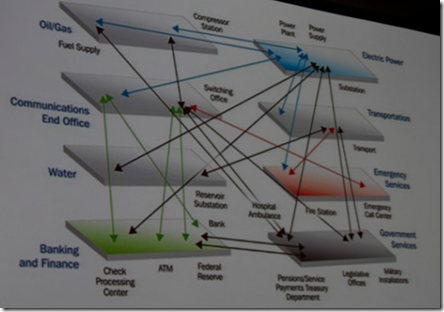One of the great talks at 7x24 Exchange was given by Alex Young on a subject few have thought about.
NASA - The Influence of Solar Flares and Solar Storms: Why We Should Care About Space Weather
The Sun produces solar storms in the form of intense radiation and fast moving material. These storms can interact with the Earth to create electric currents in our atmosphere. The study of space weather developed to predict solar storms and understand their impact on our technology. The world's electrical grids-that fundamental technology enabling modern society-are vulnerable to these currents. While most days the sun's impacts are minimal, large solar storms have the potential to have a devastating impact on mission critical systems. This talk will present an overview of Space Weather to help your business begin to prepare for worst-case scenarios.
C. Alex Young, Ph.D., Solar Astrophysicist at NASA's Goddard Space Flight Center with ADNET Systems Inc. and the SOHO/STEREO Science Team
Here is a video of Alex discussing the Solar Flare on June 7, 2011.
What are potential affects on the infrastructure is shown here.
So what? Check out this picture of what happened to a $10 Million power transformer in 1989.
And what is the affect on the electrical grid.
So other than risk of power outage what is the risk to a data center?
Luckily I sat with Alex at the speaker dinner and had a chance to chat much more and another data center executive joined in the discussion on what you could do about a solar storm that could last for days.
One choice we discussed is you could hope the arrival of solar storm is timed when it is night time and the storm strikes the other side of earth, but some storms last for days. You could turn off the servers which is a strategy used by some satellites, but not a top choice.
So what could we do? Here was my idea. Why doesn't NASA notify the data center run by a company that is fanatical about data collection and tell them is the exact time when a solar storm will arrive at the data center site. The data center operator then shares information back to NASA on error statistics that are potentially caused by the electromagnetic radiation storm. Keep running this experiment to get data to answer the question of what happens to a data center during an electrical storm.
We moved to the Data Center Social 2.0 event and continued the discussions. One idea the data center executive came up with is can we collect information about the solar storm at the data center. Alex said yes and pointed to Stanford Sudden Ionosphere Disturbance (SID).
So what is the plan. The data center executive is going to back circulate the idea which we both agreed there would be two dozen data geeks who instantly jump on the idea. Start the data collection and sharing with Alex at NASA, so he can start to answer the question of what is the effect on Solar Storms on a data center.
And, we may start an knowledge exchange that will get the data center industry ready for the peak in solar storms in 2013-2014, and answer the question what is the effect of a solar storm on a data center.






